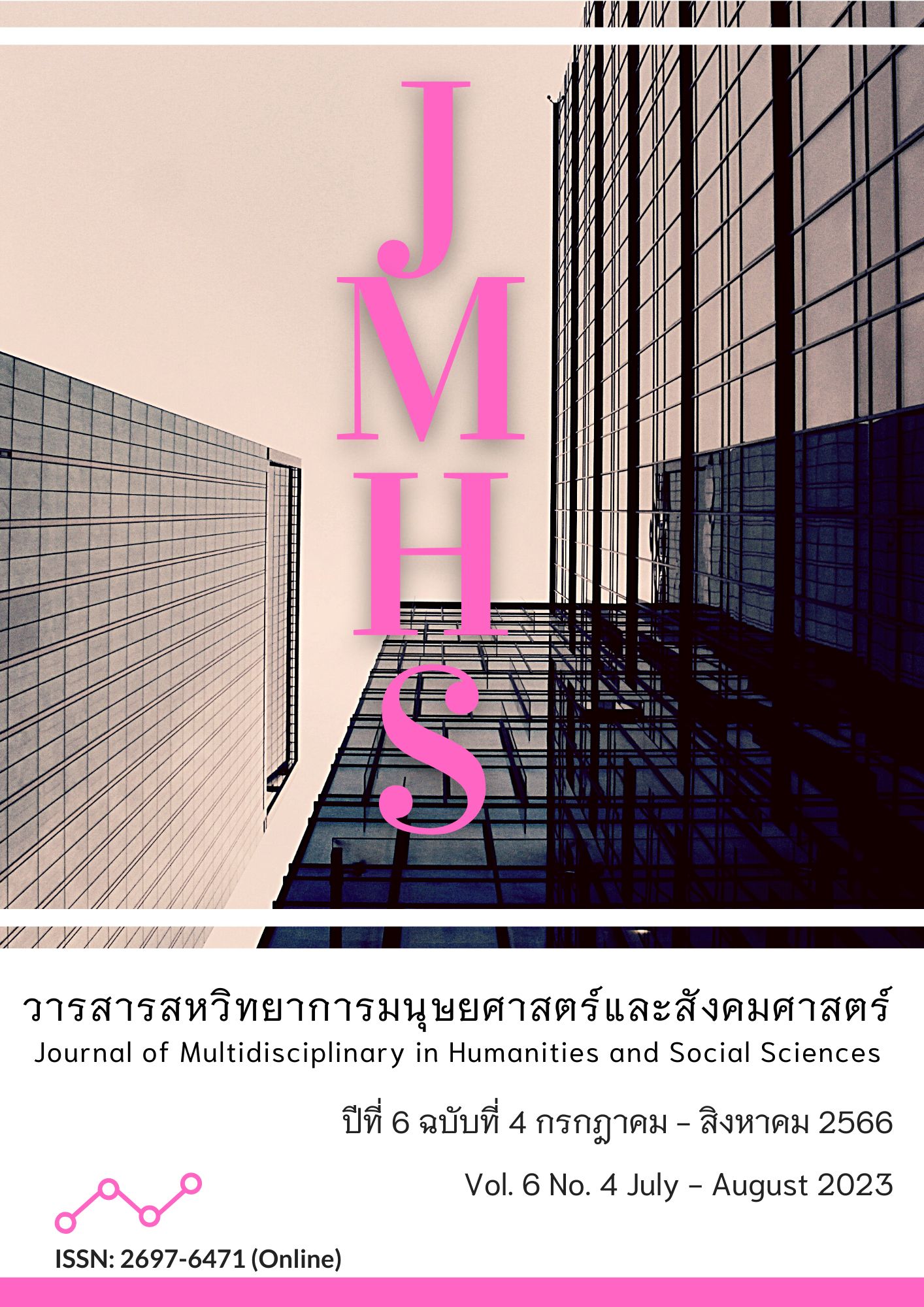The Best Practice in Administration of Secondary School Student Care-Taking System: Multiple Case Study Research
Main Article Content
Abstract
This article aimed to 1) study the problem of administration of secondary school student care-taking systems before discovering best practices, which were multi-case studies; 2) compare best practices in the administration of secondary school student care-taking systems, which were multi-case studies; and 3) present best practices in the administration of secondary school student care-taking systems. This was a qualitative multi-case study; 15 key informants were school administrators, guidance teachers, and teachers who had been involved in the student care-taking system at 5 schools that gained national honors from 2020 to 2022. Tools were semi-structured interviews and documentary research. The data analysis technique employed content analysis from field notes through transcription and analytic induction.
The study's findings were: 1. The issue is created by internal causes relating to student behaviors and following that are external issues created by the pupils' surroundings. 2. The best practices in the administration of secondary school student care-taking systems using the 5-step method of the student care system 3. The outcomes of best practices in the administration of student care-taking systems using the PDCA process. Key success factors: 1) Support for collaboration from all stakeholders; 2) Administrators’ priorities; 3) Administrators foster morale; 4) Never leave issues unsolved; 5) Establishing a clear method and framework; and 6) Choosing appropriate staff until outcomes encompass four dimensions: knowledge, skills, personality qualities, and economics. From the findings, it is possible to apply for administration of the student care-taking system in both public and private educational schools in order for students to have good physical and mental health and grow up to be good citizens of the nation.
Article Details

This work is licensed under a Creative Commons Attribution-NonCommercial-NoDerivatives 4.0 International License.
Views and opinions appearing in the Journal it is the responsibility of the author of the article, and does not constitute the view and responsibility of the editorial team.
References
กระทรวงศึกษาธิการ. (2562). พระราชบัญญัติการศึกษาแห่งชาติ พ.ศ. 2542 แก้ไขเพิ่มเติม (ฉบับที่ 4) พ.ศ. 2562. กรุงเทพฯ: โรงพิมพ์องค์การรับส่งสินค้าและพัสดุภัณฑ์.
กรมสุขภาพจิต. (2554). คู่มือครูที่ปรึกษาระบบดูแลช่วยเหลือนักเรียน. กรุงเทพฯ: ยูเรนัสอิมเมจกรุ๊ป.
ชาย โพธิสิตา. (2562). ศาสตร์และศิลป์การวิจัยเชิงคุณภาพ: คู่มือนักศึกษาและนักวิจัยสังคมศาสตร์. (พิมพ์ครั้งที่ 8). กรุงเทพฯ: อัมรินทร์พริ้นติ้งแอนด์พับลิซซิ่ง.
พรชัย เจดามาน, ขจรศักดิ์ บัวระพันธ์, โชคชัย ยืนยง, ไพรฑูรย์ พิมดี, อัคพงศ์ สุขมาตย์ และ เจริญ สุขทรัพย์. (2566). ยุทธศาสตร์การบริหารจัดการศึกษาในพลวัตศตวรรษที่ 21 สู่การเป็นประชาคมอาเซียนอย่างยั่งยืนของกลุ่มประเทศในอนุภูมิภาคลุ่มแม่น้ำโขง. วารสารสหวิทยาการมนุษยศาสตร์และสังคมศาสตร์, 6(1), 168-186. สืบค้นจาก https://so04.tci-thaijo.org/index.php/jmhs1_s/article/view/261779
นรรธพร จันทร์เฉลี่ย เสริบุตร. (2565). Learning Loss ภาวการณ์เรียนรู้ถดถอย. สืบค้นเมื่อ 2 พฤษภาคม 2565, จาก https://research.eef.or.th/learning-loss-recession/
นิลภา จิระรัตนะวรรณะ และ สุคนธ์ วรรถนะอมร. (2559). การเปรียบเทียบความสามารถ : กระบวน การพัฒนาคุณภาพศูนย์พัฒนาเด็กเล็ก. วารสารพยาบาลสาธารณสุข, 30(2), 112-123. สืบค้นจาก https://he01.tci-thaijo.org/index.php/phn/article/view/68063
ภริมา วินิธาสถิตย์กุล, ชนินันท์ แย้มขวัญยืน. (2565). การเรียนรู้เชิงรุก: แนวทางการเรียนการสอนที่เป็นเลิศในศตวรรษที่ 21. วารสารนวัตกรรมการศึกษาและการวิจัย, 6(3), 921-933. สืบค้นจาก https://so03.tci-thaijo.org/index.php/jeir/article/view/262165
มนตรี สุขชุม, วีระวัฒน์ พัฒนกุลชัย และ ภูมิภควัธจ์ ภูมพงศ์คชศร. (2566). การพัฒนารูปแบบการจัดการอาชีวศึกษาระบบทวิภาคี ประเภทช่างอุตสาหกรรม สำนักงานคณะกรรมการการอาชีวศึกษา. วารสารนวัตกรรมการจัดการศึกษาและการวิจัย, 5(1), 233-240. สืบค้นจากhttps://so02.tci-thaijo.org/index.php/jemri/article/view/259045
ยุพาวดี เกริกกุลธร. (2561). การพัฒนาสมรรถนะครูที่ปรึกษาตามแนวคิดการมีสติและการเรียนรู้จากการปฏิบัติงาน. วารสารสันติศึกษาปริทรรศน์ มจร, 6(4), 1541-1555. สืบค้นจากhttps://so03.tci-thaijo.org/index.php/journal-peace/article/view/144030
รัตนะ บัวสนธ์. (2558). วิจัยเชิงคุณภาพทางการศึกษา. (พิมพ์ครั้งที่ 5). กรุงเทพฯ: สำนักพิมพ์แห่งจุฬาลงกรณ์มหาวิทยาลัย.
สกุลรัตน์ โกพัฒน์ตา, วิภาภรณ์ ภู่วัฒนกุล, อัจฉรา วัฒนาณรงค์ และ โกศล มีคุณ. (2564). คุณภาพนักเรียนกับระบบการดูแลช่วยเหลือนักเรียนในสถานศึกษา. Journal of Roi Kaensarn Academi, 6(8), 371-387. สืบค้นจาก https://so02.tci-thaijo.org/index.php/JRKSA/article/view/249019
สมพงษ์ จิตระดับ. (2560). เด็กไทยวันนี้. มติชนออนไลน์. สืบค้นเมื่อ 15 พฤษภาคม 2565, จาก www.matichon.co.th/news/418603
สหประชาชาติ. (2566). เป้าหมายการพัฒนาที่ยั่งยืนในประเทศไทย : การศึกษาที่มีคุณภาพ. สืบค้นเมื่อ 20 เมษายน 2566, จาก https://thailand.un.org/th/sdgs/4
สำนักงานคณะกรรมการการศึกษาขั้นพื้นฐาน. (2559). การพัฒนาระบบการดูแลช่วยเหลือนักเรียน. กรุงเทพฯ: ชุมนุมสหกรณ์การเกษตรแห่งประเทศไทย.
สำนักวิชาการและมาตรฐานการศึกษา. (2552). ระบบการดูแลช่วยเหลือนักเรียน หลักการ แนวคิด และทิศทางในการดำเนินงาน. กรุงเทพฯ: คุรุสภาลาดพร้าว.
Bogdan, R. C., & Biklen, S. K. (1992). Qualitative Research for Education: An Introduction to Theory and Methods. Boston: Allyn and Bacon.
Moser, A., & Korstjens, I. (2018). Practical Guidance to Qualitative Research: Sampling, Data Collection and Analysis. European Journal of General Practice, 24(1), 9-18. https://doi.org/10.1080/13814788.2017.1375091
Wang, C., & Li, H. (2022). Do Not Worry About Less but Worry About Inequality: The Importance of Interactive Fairness in The Performance Appraisal of University Faculty. International Journal of Multidisciplinary in Management and Tourism, 6(2), 169–186. https://doi.org/ 10.14456/ijmmt.2022.14


